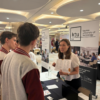Due to social distancing protocols, recruiting today put the emphasis on the accelerated digital transformation that was expected to take a little bit longer happening instead in a few months. Despite the obvious logistical challenges and loss in human interaction, it’s possible to maintain the value of live settings while redefining the experience with hybrid & virtual career fairs. And more, diversity is finally being treated with the accountability it always deserved.
So, if you’re going to organize a virtual university career fair, here are 6 things you need to know to make it work.
1. Why are Virtual Job Fairs Important for Universities
Virtual career fairs for universities actually lead to results and so far, the quality and reach of students seem to be considerably high. And there’s a very logical explanation for this. The current generation of students grew up in an almost purely digital world, meaning that they spend the majority of their time interacting and communicating online. We have to admit it, there’s a lot of momentum in instant messaging.
So, allowing students to connect with employers from their own comfort zones through robust chat tools and video call interviews will allow them to focus less on the environment and more on telling their stories over enriched conversations. In turn, employers get a better idea of the student’s skills and experience.
This effective dynamic of virtual recruitment will attract more recruiters, more students and increase the notoriety of the university itself, which in turn will gain a better opportunity to highlight its positioning. That’s why virtual & hybrid career fairs are so attractive to students and, consequently, a great opportunity for universities.
Get to know the challenges and benefits of organizing a virtual job fair.
2. Crucial Tools to Organize a Virtual Career Fair
There are some essential features you’ll need to consider when choosing the best virtual career fair platform, such as virtual stands, chat rooms, live streaming and other video production tools, and also the ability to add presentations and videos. Let’s get to the bottom of it:
-
Online registration tools
Both students and recruiters must register online for the virtual job fair, submit their data and upload their CVs and LinkedIn profiles. Without this step, you won’t be able to effectively measure your attendance rate and engagement levels.
-
Content upload & sharing tools
Let companies tell their story by sharing engaging content about their mission and values, such as videos, brochures, presentations and more. Plus, enable them to autonomously customize their job offers. And let candidates take content with them so they can decide better if they want to digitally share their CVs with a specific company.
-
Recruiter halls & virtual stands
Firstly, students should have a view from all exhibitors and then, when they click on each one of them, they should be able to enter on their virtual stand and search for specific details. Looking for the right company is as simple as applying filters or downloading summaries for future reference. They should also be able to apply to any available job offer at any given time.
-
Online chat
To get in touch with recruiters, students should be able to start an online chat or participate in specific workshops or sessions. The chat recruitment tool should also be available for recruiters, so they can interact and start a relationship with students at first hand. If they’re still unsure about a specific candidate, they should be given the possibility to mark its profile as favorite and revisit it later.
-
Personal agendas
Once students click on a job offer of their interest, they must be able to see all the details and apply for it. The application should also be immediately visible to the recruiter, who should be able to instantly invite them to a video call interview. Score extra points with your virtual platform for career fairs that allows interview schedules to appear within personal agendas of both candidates and recruiters, so they can be notified.
-
Virtual interview scheduling
Recruiters should be able to get the most out of video call interviews, either within group sessions or one-to-one facetime interviews, along with the ability to take notes to profiles in order to help them organize applicant databases.
-
Engagement tools
Recruiters should also have the means to engage candidates and make it a conversation by conducting unlimited live streaming and Q&A sessions, webinars or workshops. They should also be able to keep job seekers engaged with event gamification ideas, just like quizzes or leaderboards.
-
Analytical tools
Detailed reports are a must if you want to break down your virtual fair performance and candidate participation, so you can improve ROI and refine your approach. The right metrics should include attendance breakdowns and attendee engagement with virtual stands and content offerings.
3. Features for Recruiters & Students
As a major mechanism for facilitating student-employer engagement and driving career center revenue, we knew that attributing the right virtual career fair features to the right players is the key for a meaningful virtual experience. Let’s focus on the featured tools for recruiters, but also on the shared ones:
For recruiters
- – Recruiter halls
- – Virtual stands
- – Virtual interview scheduling
- – Live streaming
- – Q&A sessions
- – Workshops / Webinars
- – Note taking & bookmarking
- – Gamification
- – Reports & analytics
For recruiters & students
- – Online registration
- – Content upload & sharing
- – Online chat
Despite the discrepancy on the above table, it’s important to ensure equal networking opportunities for both sides, meaning that recruiters should be able to effectively connect with candidates through robust engagement tools, but at the same time give candidates the opportunity to content their eagerness to learn more about the recruiting companies / job vacancies.
4. Measuring The Success of a Virtual Job Fair in a University
After following the 4 essential steps to hosting a virtual job fair, it’s important to find out if its performance was worthwhile. Measuring the success of a virtual job fair within an academic environment must encompass not only performance indicators related to candidate engagement, but also regarding the performance and interest aroused by each recruiter. In this way, you’ll be able to take better and data-driven decisions for future editions regarding partnering with the more appealing companies. The ones that have proven most relevant in the context of your virtual university career fair. Let’s go through some important metrics:
-
Candidate participation
In this regard, you can track the number of total registrations, total number of logged-in users, unique logins or the number of visits to each company’s virtual stands.
-
Employer participation
Regarding the performance of each recruiter, you can quantify the number of total virtual stands’ visits, unique virtual stands’ visits, total tab clicks or clicks per tab. You can go further and account for other types of interactions, just like the number of total documents downloaded, downloads per document, total video views and views per video. Getting some statistics about the chat volume will be “icing on the cake”.
-
Specific session attendance
If employers decide to include webinars or workshops in their agendas to better draw the attention of candidates, don’t forget to also measure its performance. You can easily do it by monitoring the total number of attendees and also the number of attendees per session. This is a good way to take notice of the students’ interest in certain topics.
5. Developing Other Virtual Events in Universities
You don’t have to stick to virtual job fairs. Whether it’s for reasons of reducing student attendance at universities or not, be aware that there are other events that universities can organize within a virtual environment. Remember, what may have started as a safe alternative is now breaking new ground in effectively hosting events worldwide. We came up with some ideas that could help you energize some of your traditional school activities:
- Virtual Campus Tours;
- Course Q&As;
- Course Chats;
- Onboarding Events;
- Virtual Open Days.
6. Future Trends for Virtual & Hybrid Recruiting Events in Universities
It’s been truly challenging times, and university recruitment looks different than ever before. To help you manage these changes and get ahead of what’s coming next, here are some forethoughts about the future of college recruiting and what trends employability departments should have in mind for hiring seasons ahead:
- Virtual recruiting is here to stay;
- Virtual recruiting will play a major role on diversity;
- Hybrid career fairs will arrive at full speed (if this one got you curious, find out how virtual & hybrid job fairs can speed recruitment);
- Fast technological change will keep demand for more agility;
- Expectations of candidates will keep risen exponentially;
- Students will prioritize diversity and inclusion;
- Empathy and personalized experiences will be meaningful to attract top, diverse talent in a virtual world;
- The digitalization of processes and the redefinition of non-exclusive sponsorships between providers have fueled the competition for candidates’ attention and engagement;
- And the most important one, how companies react to this difficult period and support their workers will have a long term effect on employer brand.








